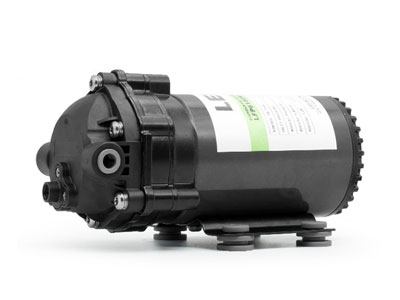Pump
Reverse Osmosis is the reverse process of natural osmosis. Solutions with low salinity and low density have a natural tendency to migrate to solutions with high salinity and high density. The reverse osmosis membrane divides the water into two pass way, the Permeated water pass through the RO membrane to the clean water tank, and the rejected water going to the waste solution tank. The RO system will remove the majority of dissolved salts, contaminants, bacteria, and things that make water taste bad. By applying pressure the efficiency of purifying water is greater than the naturally Reverse Osmosis.
When water pressure is under 40 PSI, The RO system may generate less RO water while having more contaminants in the RO water. Most RO membranes need a water pressure of at least 60 PSI. A LEFOO RO AC pump will bump the water pressure to 75 PSI. LEFOO also offers custom RO pumps with over 80 PSI pressure. LEFOO booster pump for water purifier will feed your RO system at a 70 PSl pressure. It is very quiet and totally automatic. When the LEFOO water pump controller or LEFOO pressure switch installs in the tube that connects the tank to the unit. It shuts off automatically when the tank is full.
Pre-Permeate is critical for the lasting of an RO water system to prevent fouling, and too frequent cleanings, and premature failure of the span RO membrane. Here are common RO system issues about Pre-Permeate.
Fouling happens when contaminants accumulate and clogging on the membrane surface. There are many contaminants in municipal feed water that are naked to the human eye and harmless for human consumption, but large enough to quickly foul (or clog) an Reverse Osmosis System. Fouling typically exists in the front end of a bare RO system without filters and results in a lower actual RO pressure and a lower permeate flow.
1. Particulate or colloidal matter (dirt, silt, clay, etc.)
2. Organics (humic/fulvic acids, etc)
3. Microorganisms (bacteria, etc).
4. Breakthrough of filter media upstream of the RO unit. GAC carbon beds and softener beds may develop an under-drain leak and if there is not adequate post-filtration in place the media can foul the RO system.
5. SCALING: An example of a common scale that tends to form on an RO membrane is calcium carbonate (CaCO3).
6. CHEMICAL ATTACK: Oxidizers such as chlorine will 'burn' holes in the membrane pores and can cause irreparable damage.
7. MECHANICAL DAMAGE
'Dry Start' may generate excessive back pressure that can cause permanent membrane damage, you might need a pressure switch to protect the RO system.
Here are Pre-Permeate solutions for RO systems
1. A Multi-Media Filter (MMF)is used to help prevent fouling of an RO system.
It is important to have a 5-micron cartridge filter placed directly after the MMF unit to prevent the MMF media from damaging downstream pumps and fouling the RO system.
2. Microfiltration (MF) is effective in removing colloidal and bacteria matter and has a pore size of only 0.1-10µm.
3. Antiscalants and scale inhibitors are chemicals that can be added to feed water before an RO unit to help reduce the scaling potential of the feed water.
4. A water softener can be used to help prevent scaling in an RO system by exchanging scale-forming ions with non-scale forming ions.
5. By adding sodium bisulfite (SBS or SMBS), which is a reducer, to the water stream before an RO at the proper dose you can remove residual chlorine.
6. Granular activated carbon is used for both removing organic constituents and residual disinfectants (such as chlorine and chloramines) from water.
Those Pre-Permeate Solutions need correct designs, maintenance programs, and experienced service support, your RO water system could serve many years of high purity water. Most RO membranes need at least 60 psi pressure to work well, if the water pressure is too low you need to retrofitted an AC RO pump.
16 Mar 2025
Types of Pump for Water Purifiers and Analysis of Malfunctions01 Mar 2025
Knowledge About Refrigerant Pressure Transducers13 Feb 2025
LEFOO Showcases Innovations at Aquatech Amsterdam 202512 Jun 2024
Unlocking Clean Water: How Booster Pumps Enhance Purification SystemsProduct Inquiry
 English
English  français
français  Deutsch
Deutsch  Español
Español  italiano
italiano  русский
русский  português
português  العربية
العربية  Türkçe
Türkçe  Zulu
Zulu 
